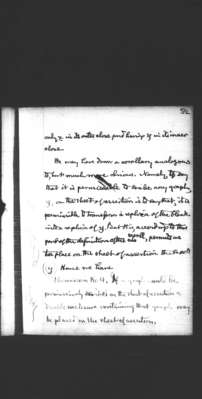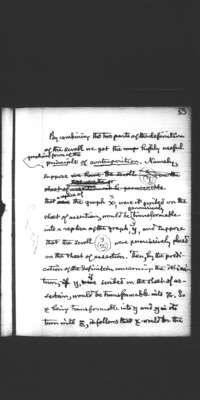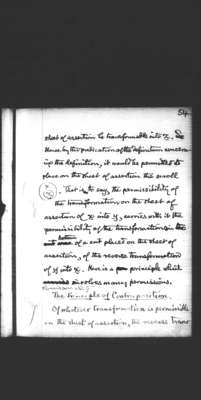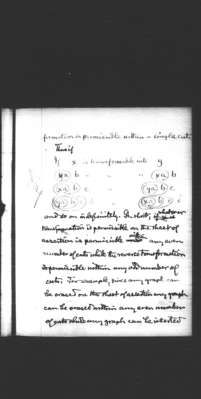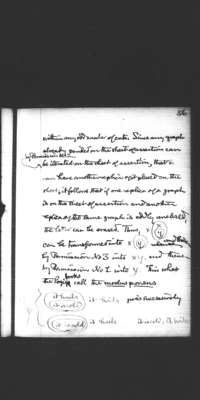Pages
56
52
only x in its outer close and having y in its inner close.
We may here draw a corollary analogous to, but much more obvious. Namely, [To?] say that it is permissible to scribe any graph, y, on the sheet of assertion is to say that, it is permissible to transform a replica of the blank into a replica of y. But this, according to this part of the definition of the scroll, permits us to place on the sheet of assertion the scroll Hence we have
Permission No 4. If a graph could be permissively scribed on the sheet of assertion a double enclosure containing that graph may be placed on the sheet of assertion.
57
53
By combining the two parts of the definition of the scroll we get the highly useful graphical form of the principle of contraposition. Namely, suppose that a replica of the graph x, were it scribed on the sheet of assertion, would be permissively transformable into a replica of the graph, y, and suppose that the scroll were permissively placed on the sheet of assertion. Then, by the predication of the definition concerning the definitum, y, if scribed on the sheet of assertion, would be transformable into z. So x being transformable into y and y in its turn into z, it follows that x would [on?] the
58
54
sheet of assertion be transformable into z. Hence by the predication of the definitum concerning the definition, it would be permitted to place on the sheet of assertion the scroll That is to say, the permissibility of the transformation on the sheet of assertion of x into y, carries with it the permissibility of the transformation on the cut area bottom of a cut placed on the sheet of assertion, of the reverse transformation of y into x. Here is a principle which carries involves many permissions.
Permission No 5
The Principle of Contraposition.
Of whatever transformation is permissible on the sheet of assertion, the reverse transformation
59
is permissible within a single cut.
Thus if If x is transformable into y ... and so on indefinitely. In short, whatever transformation is permissible on the sheet of assertion is permissible within any even number of cuts while the reverse transformation is permissible within any odd number of cuts. For example, since any graph can be erased on the sheet of assertion any graph can be erased within any even number of cuts while any graph can be inserted
60
56
within any odd number of cuts. Since any graph already scribed on the sheet of assertion can by Permission No 2 be iterated on the sheet of assertion, that is can have another replica of it placed on the sheet, it follows that if one replica of a graph is on the sheet of assertion and another replica of the same graph is oddly enclosed, the latter can be erased. Thus, x can be transformed into x and thence by Permission No 3 into xy. and thence by Permission No 1 into y. [Thus?] what the logic books call the modus ponens it hails gives successively it hails it is cold . it hails
